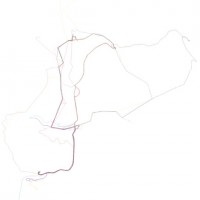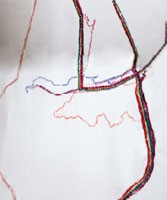Transit Textiles
Materials:
Cotton, acrylic paint, dressmaker’s dummies and video.
Concept:
The socio-cultural construction of urban space is a dynamic and continuous meaning making process. This artistic intervention illuminates and maps the plethora of geospatial interrelations and personal connections that are made (and lost) as we move through a physical urban space.
The accentuation is on movement. The passages we make when we move through; the public and the private, the local and the global, between centrality and marginality, and amid the personal and the commercial environments that exist in urban spaces. The project is a combined geospatial and cultural analysis of the city.
The focus is on one of Hong Kong’s cultural hubs – the Academy of Visual Arts. This project acts as a catalyst for civic participation, bringing together eight artists from various backgrounds and disciplines, engaging them as they move though the city. And by way of art practice and audience participation, the data is mapped memorialising the traces made from daily routines into keepsakes of the city. The mapping reveals the personal, yet public and collective, experiences of the city. These movements are then realised in textile form.
For almost all humans, textile or cloth is the substance that we begin with (birth) and end with (death). Fabric is a significant substance for all. We use a daily set of cloths to cover and wrap the body, there are the cloths we use only in domestic environments, and those for special occasions, but it is the most ordinary textiles that are in most demand at times of need or distress. This is when we get out a blanket (or a canopy), a sacred cloth and a second skin.
Flanagan creates wearable textile maps according to the data accumulated over 21 days – making the art both organic and emergent yet structured. The wearables evidence the activity of their becoming, coming into being on the street as Flanagan engages with participants while embroidering the results into the weft. By means of stitching Flanagan maps the networks of movement into the cloth. The patterns that are created evoke the free flow of the individual in public space.
We are less connected to public spaces and places. The mobile phone is one device that enables this boundary creation. Through our mobile phones we keep close and connected to the people and spaces from our private lives – those we already know – rather than connecting to those who are around us in the city landscape. This project maps and connects people who are unfamiliar to each other yet are all familiar with the space of the city. In doing so the project also elucidates and examines ‘boundaries’ – we as artists are working though our boundaries of culture and language – but we are also asking people to reflect on their own boundaries of space and place.
Contemporary citizens in fast moving economies reveal a great deal about the changing dynamic of contemporary cultural life. Mobile individuals moving through a city create boundaries to manage their interchanges in the urban landscape. Contemporary cities are mediated spaces. The reputation of a city is an advertorial and marketed space. It is a structured space. It is an environment in which we ‘buy’ ourselves into, this project is an attempt to probe these boundaries and re-personalise the space. This project facilitates citizens to transition from structure to a reflexive position the modern urban space.
The ‘nomadic data stitching station’ is relocatable where ever a power source is available. Like a busker, the artist carries what she needs to set up and engage with participants by locating herself in the flow of traffic. Information gathered is sewn directly onto the cloth, embroidered into network maps.
Project partners:
- Clare Llyode, (The University ofNewcastle),
- Timm Burkhardt, (YouAreWatchingUs).
Exhibitions:
- 21 Days, The Academy of Visual Art Gallery, Hong Kong Baptist University, Kowloon, Hong Kong, 2nd October to 18th October 2009.
Multi Media:
- http://triciaflanagan.com/. Accessed 2nd November 2009.
- http://ava.hkbu.edu.hk/[…]id=203 Accessed 9th December 2009.
Thanks:
Funding support by The Academy of Visual Arts, Hong Kong Baptist University and the generous support of:
- Proffesor Qingli Wann
- Dr. Siu Kee Ho
- Dr. Wing Yan Vivian Ting
- Dr Sai Chong Jack Lee
- Chein Hui Kuo
- Wai Ching Bryan Chung
- Lai Kuen Annie Wan
- Wai Luen FrancisYu
- Heidi Chan
- Levi Lam
- Phillis Ting
- Sunday Lai
- Fanny Chan
- Yung Cheung
- Cornelia Erdmann















